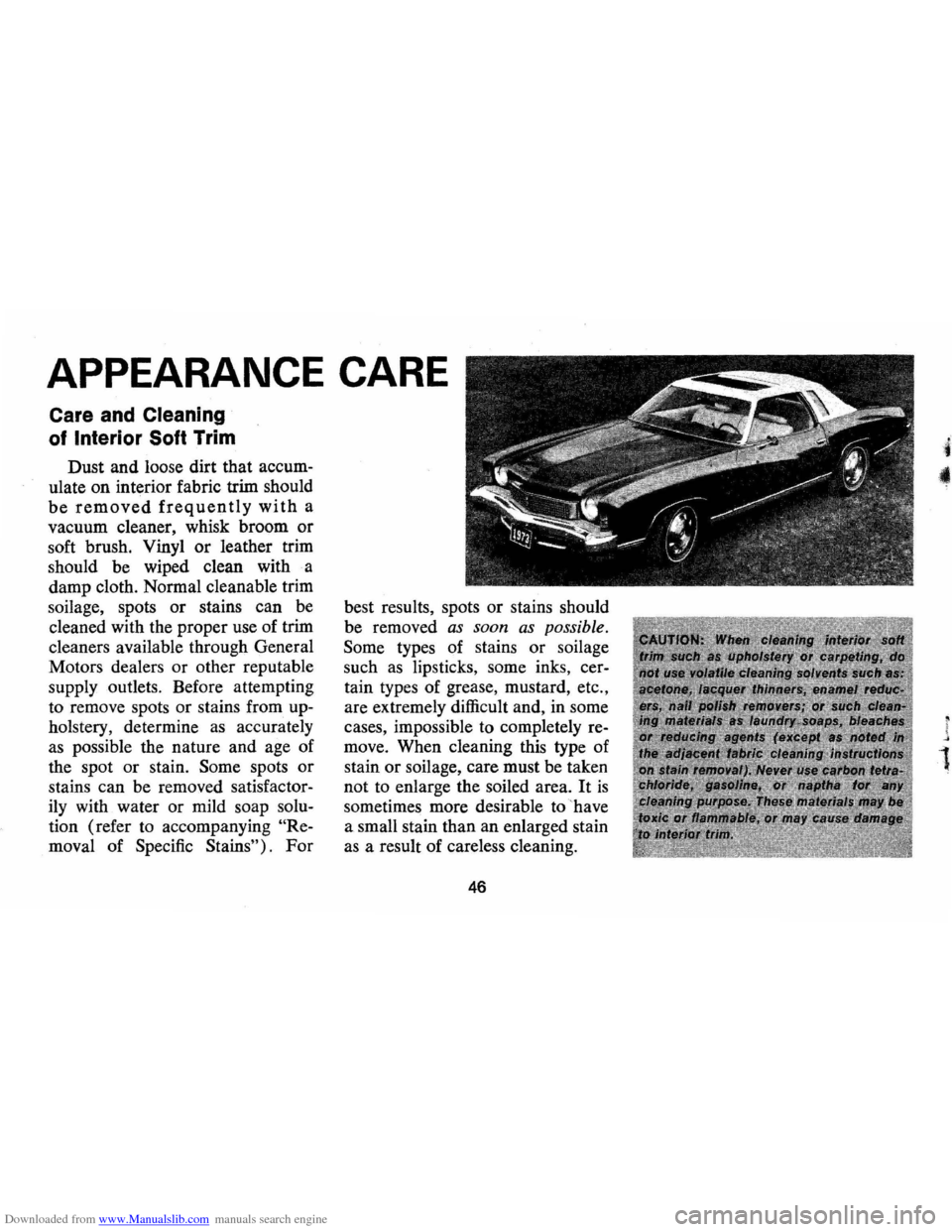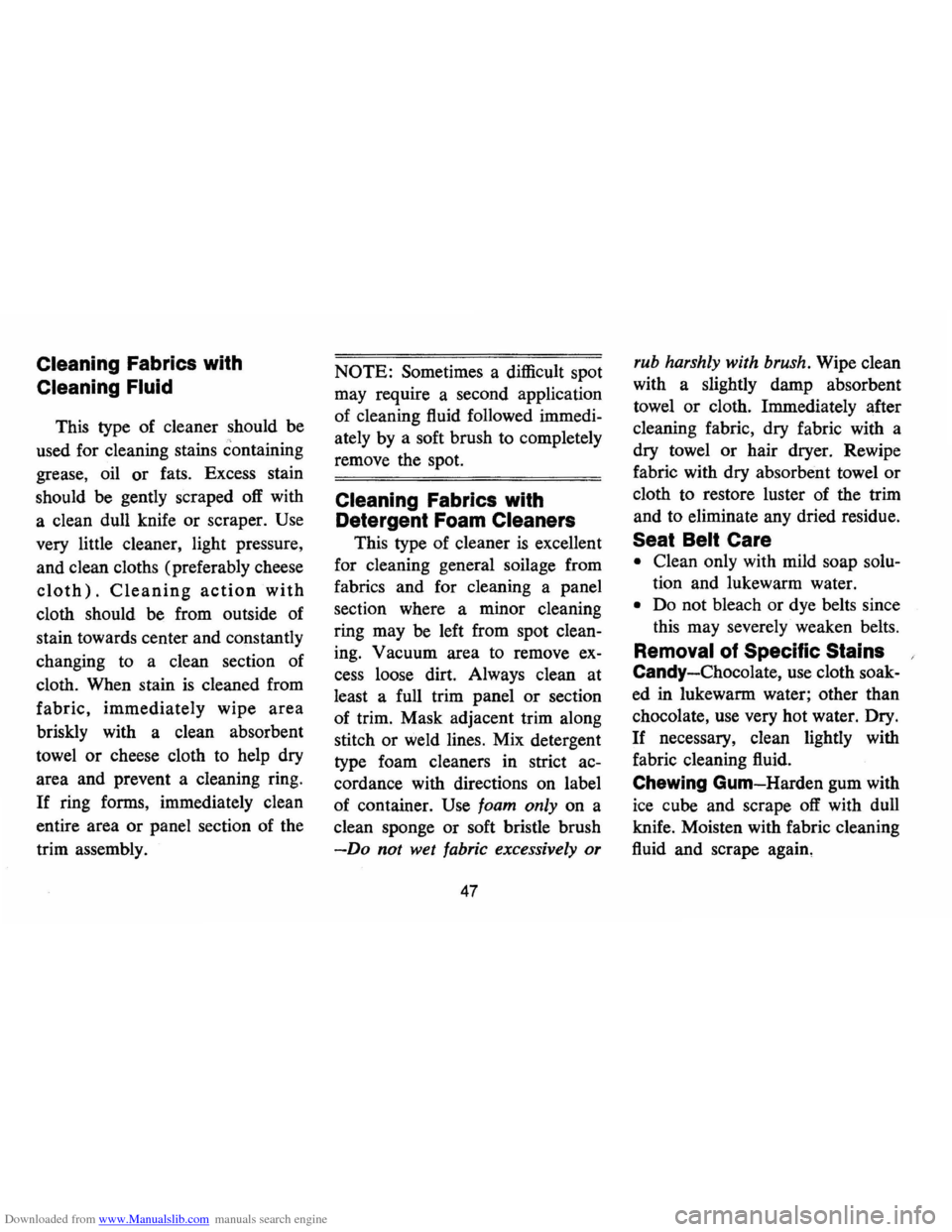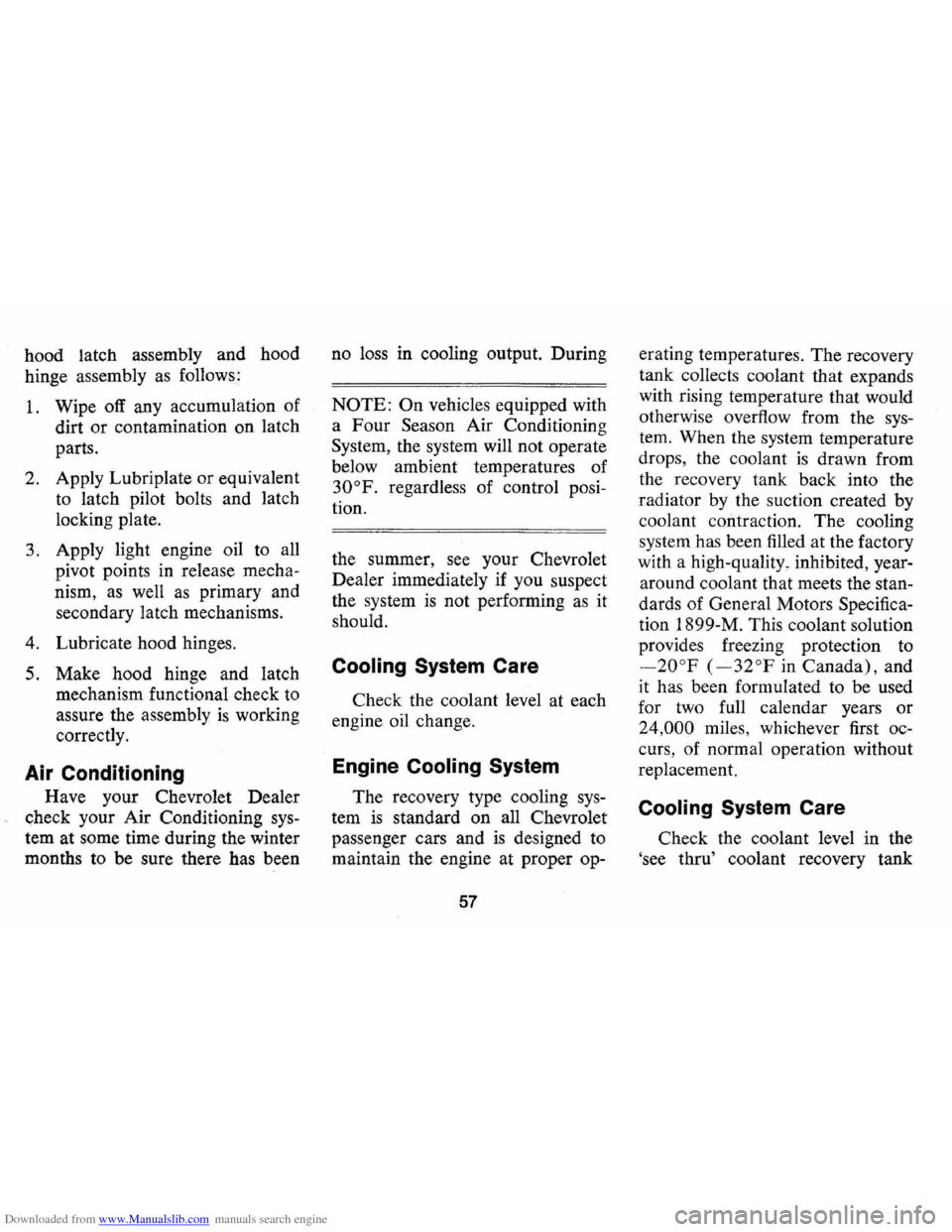1973 CHEVROLET MONTE CARLO oil type
[x] Cancel search: oil typePage 48 of 86

Downloaded from www.Manualslib.com manuals search engine APPEARANCE CARE
Care and Cleaning
of Interior Soft Trim
Dust and loose dirt that accum
ulate on interior fabric trim should
be removed frequently with a
vacuum cleaner, whisk broom or
soft brush. Vinyl
or leather trim
should be wiped clean with a
damp cloth. Normal cleanable trim
soilage, spots or stains can be
cleaned with the proper use of trim
cleaners available through General
Motors dealers or other reputable
supply outlets. Before attempting
to remove spots or stains from
up
holstery, determine as accurately
as possible the nature and age of
the spot or stain.
Some spots or
stains can be removed
satisfactor
ily with water or mild soap solu
tion (refer to accompanying "Re
moval of Specific Stains"). For
best results, spots or stains should
be removed
as soon as possible.
Some types of stains or soilage
such
as lipsticks, some inks, cer
tain types of grease, mustard, etc.,
are extremely difficult and, in some
cases, impossible to completely
re
move. When cleaning this type of
stain or soilage, care must be taken
not to enlarge the soiled area.
It is
sometimes more desirable to have
a small stain than an enlarged stain
as a result of careless cleaning.
46
1
Page 49 of 86

Downloaded from www.Manualslib.com manuals search engine Cleaning Fabrics with
Cleaning
Fluid
This type of cleaner should be
used for cleaning stains containing
grease, oil or fats. Excess stain
should be gently scraped off with
a clean dull knife or scraper.
Use
very little cleaner, light pressure,
and clean cloths (preferably cheese
cloth). Cleaning action with
cloth should be from outside of
stain towards center and constantly
changing to a clean section of
cloth. When stain
is cleaned from
fabric, immediately wipe
area
briskly with a clean absorbent
towel or cheese cloth to help dry
area and prevent a cleaning ring.
If ring forms, immediately clean
entire area or panel section of the
trim assembly.
NOTE: Sometimes a difficult spot
may require a second application
of cleaning fluid followed immedi
ately by a soft brush to completely
remove the spot.
Cleaning Fabrics with
Detergent Foam Cleaners
This type of cleaner is excellent
for cleaning general soilage from
fabrics and for cleaning a panel
section where a minor cleaning
ring may be left from spot clean
ing. Vacuum area to remove ex
cess loose dirt. Always clean at
least a full trim panel or section
of trim. Mask adjacent trim along
stitch or weld lines. Mix detergent
type foam cleaners in strict ac
cordance with directions on label
of container.
Use foam only on a
clean sponge or soft bristle brush
-Do not wet fabric excessively or
47
rub harshly with brush. Wipe clean
with a slightly damp absorbent
towel or cloth. Immediately after
cleaning fabric, dry fabric with a
dry towel or hair dryer. Rewipe
fabric with dry absorbent towel or
cloth to restore luster of the trim
and to eliminate any dried residue.
Seat Belt Care
• Clean only with mild soap solu
tion and lukewarm water.
• Do not bleach or dye belts since
this may severely weaken belts.
Removal of Specific Stains
Candy-Chocolate, use cloth soak
ed in lukewarm water; other than
chocolate, use very hot water. Dry.
If necessary, clean lightly with
fabric cleaning fluid.
Chewing Gum-Harden gum with
ice cube and scrape off with dull
knife. Moisten with fabric cleaning
fluid and scrape again,
Page 50 of 86

Downloaded from www.Manualslib.com manuals search engine Fruit Stains, Coffee, Soft
Drinks, Ice Cream and Milk
Wipe with cloth soaked in cold
water.
If necessary clean lightly
with fabric cleaning fluid.
Soap
and water is not recommended as
it might set the stain .
Catsup-Wipe with cloth soaked
in cool water.
If further cleaning
is necessary, use a detergent foam
cleaner.
Grease, Oil , Butter, Margarine
and Crayon -Scrape off excess
I with dull knife. Use fabric clean
ing fluid.
Paste or Wax Type Shoe Polish
-Light applications of fabric
cleaning fluid.
Exterior Appearance
Your car is finished with General
Motors
" Magic-Mirror" acrylic lac
quer. This
is a finish of maximum
beauty which, in depth of color,
Tar -Remove excess with dull
knife, moisten with fabric clean
ing fluid, scrape again, rub lightly
with additional cleaner.
Blood -Wipe with clean cloth
moistened with cold water.
Use
no soap.
Urine -Sponge stain with luke
warm soap suds from mild neutral
soap on clean cloth, rinse with
cloth soaked in cold water, satu
rate cloth with one part house
hold ammonia and 5 parts water,
apply for 1 minute, rinse with
clean, wet cloth.
Vomitus-Sponge with clean cloth
dipped in clean, cold water. Wash
gloss retention and durability
is
superior to conventional lacquer
finishes.
Washing Your Car
The best way to preserve the
finish and maintain original beauty
48
lightly with lukewarm water and
mild neutral soap.
If odor persists,
treat area with a water-baking soda
solution (1 teaspoon baking soda
to one cup of tepid water). Rub
again with cloth and cold water.
Finally, if necessary, clean lightly
with fabric cleaning fluid.
Interior Glass Surface
The interior glass surface should
be cleaned on a periodic basis for
continued good visibility. A com
mercial household glass cleaning
agent containing ammonia will re
move normal tobacco smoke and
dust
films sometimes caused by
ingredients used in vinyls, plastics
or other interior trim materials.
of appearance
is to keep it clean.
Wash the car in lukewarm or cold
water . Never use strong
soap or
chemical detergents. Cleaning
agents should be quickly flushed
from the surfaces.
Page 51 of 86

Downloaded from www.Manualslib.com manuals search engine Polishing and Waxing
Your Car
Although acrylic paint on your
car
is durable, you may wish to
wax or polish for added protection.
Your Chevrolet Dealer offers many
polishes and waxes now available
which have proven of real value
in
maintaining a good paint finish.
When using a tar and road oil
remover, be certain it
is safe for
use on acrylic painted surfaces.
Protection of Exterior
Bright
Metal Parts
Bright metal parts should be
cleaned regularly to maintain
luster. Washing with water is all
that
is usually required. However,
G.M. Chrome
Polish may be used
on CHROME or STAINLESS
STEEL
trim if necessary.
Use special care with ALU
MINUM trim. Never use auto or
chrome polish, steam or any caustic
soap to clean aluminum.
A coating of wax, rubbed to a
high polish,
is recommended for
all bright metal parts.
Cleaning White Sidewall
Tires
Use a tire cleaner which will
not harm aluminum trim. A stiff
brush may be used with the cleaner
to remove road grime and dirt
from white sidewall tires.
Cleaning the Optional
Vinyl
Top
The top should be washed fre
quently with neutral soap suds,
lukewarm water and a brush with
soft bristles. Rinse top with
suffi
cient quantities of clear water to
remove all traces of soap.
If the top requires additional
cleaning after using soap and
water, a mild foaming cleanser
can be used. Rinse the whole top
with water; then apply a mild
49
foaming type cleanser on an area
of approximately
--two square feet.
Scrub area with a small soft bristle
hand brush adding water
as neces
sary until the cleanser foams to
a soapy consistency. Remove the
first accumulated soilage with a
cloth or sponge before it can be
ground into the top material.
Apply additional cleanser to the
area and scrub until the top
is
clean. Care must be exercised to
keep the cleanser from running
onto body finish
as it may cause
streaks
if allowed to run down
and dry. After the entire top
has been cleaned, rinse generously
with clear water to remove all
traces of cleanser.
Do not use
volatile cleaner or household
bleaching agents on the top
material.
I
Page 59 of 86

Downloaded from www.Manualslib.com manuals search engine hood latch assembly and hood
hinge assembly as follows:
1. Wipe off any accumulation of
dirt or contamination on latch
parts.
2. Apply Lubriplate or equivalent
to latch pilot bolts and latch
locking plate.
3. Apply light engine oil to all
pivot points in release mecha
nism, as well
as primary and
secondary latch mechanisms.
4. Lubricate hood hinges.
5. Make hood hinge and latch
mechanism functional check to
assure the assembly
is working
correctly.
Air Conditioning
Have your Chevrolet Dealer
check your Air Conditioning
sys
tem at some time during the winter
months to be sure there has been no
loss in cooling output. During
NOTE: On vehicles equipped with
a
Pour Season Air Conditioning
System, the system will not operate
below ambient temperatures of
300P. regardless of control posi
tion.
the summer,
see your Chevrolet
Dealer immediately if you suspect
the system
is not performing as it
should .
Cooling System Care
Check the coolant level at each
engine oil change.
Engine Cooling System
The recovery type cooling sys
tem is standard on all Chevrolet
passenger cars and
is designed to
maintain the engine at proper op-
57
erating temperatures. The recovery
tank collects coolant that expands
with rising temperature that would
otherwi se overflow from the sys
tem. When the system temperature
drops, the coolant
is drawn from
the recovery tank back into the
radiator by the suction created by
coolant contraction. The cooling
system has been filled at the factory
with a high-quality , inhibited, year
around coolant that meets the stan
dards of General Motors Specifica
tion 1899-M. This coolant solution
provides freezing protection to
-20oP (-32° P in Canada), and
it has been formulated to be used
for two full calendar years or
24,000 miles, whichever first oc
curs, of normal operation without
replacement.
Cooling System Care
Check the coolant level in the
'see thru' coolant recovery tank
Page 62 of 86

Downloaded from www.Manualslib.com manuals search engine • Maintain cooling system freeze
protection at
.;...200 F or below
to ensure protection against
corrosion and loss of coolant
from boiling , even though freez
ing temperatures are not
ex
pected.
• Add ethylene glycol base cool
ant that meets GM Specification
1899-M when coolant additions
are required because of coolant
loss or to provide additional
protection against freezing at
temperatures lower than
_200 F
(_320 F in Canada).
NOTE: Alcohol or methanol base
coolants or plain water are not
recommended for your Monte
Carlo at any time.
Radiator Pressure Cap
The radiator cap, a 15 lb. pres
sure type, must be installed tightly,
otherwise coolant may be lost and
damage to engine may result from
overheating. Radiator pressure caps
should be checked periodically for
proper operation.
If replacement is
required specify AC.
Thermostat
The cooling system is protected
and controlled by a thermostat in
stalled in the engine coolant outlet
to maintain a satisfactory operating
temperature of the engine. This
thermostat
is designed for continu
ous use through both winter and
summer and need not be changed
seasonally . When replacement
is
necessary, Delco parts are recom
mended.
60
Tires
The factory installed tires on
your car
as shown on the following
Tire Usage chart are designed to
provide the best all around per
formance for normal vehicle op
eration. When inflated
as recom
mended on the tire pressure plac
ard, located on the left door of
your vehicle, they have the load
carrying capacity to operate satis
factorily at all normal highway
speeds.
Tire Care
Tires should be checked regu
larly for proper inflation pressure,
wear, and damage. The following
information will assist you in prop
erly caring for your tires:
Page 74 of 86

Downloaded from www.Manualslib.com manuals search engine SPECIFICATION
VEHICLE IDENTIFICATION NUMBER
Car-Stamped on Vehicle Identification Plate attached at left of instrument panel.
Engine-Stamped on boss on block .
8 -Cylinder-On right side of block at front.
Body-S tamped o n plate attached to cowl panel.
DIMENSIONS
MONTE
CARLO
O ve rall length
2-Door Coupe ...
.. . . . . . . . . . . . . . . . . . . . . . . 211.5"
Width ... ......... ......... ............ . . 77.6"
Wheelbase ............................... 116.0"
BATTERY RATING
350 VB engine equipped vehicles-12 volt, 66 plate, 2900 watts '
454 VB and Heavy Duty-12 volt, 90 plate, 3750 watts'
' Cranking
powe r at O°F.
CAPACITIES
Gasoline Tank (approx.) ....... . B Cylinder
Oil change only ... ... .... .... . Oil and Filter change .......... .
U.S. Measure
22 gal.
4 qt. 5 qt.
Imperial Measure
18% gal.
3% qt. 4% qt.
71
Cooling System: ...... 350 v-a
u.s. Measure (qts.) 16*
Imperial Measure (qts.) 13.25*
454 v-a
23*
19.25*
'with air cond o add 1 qt. U.S. meas. (% qt. Imperial meas.)
Thermostat
All engines . . . . . . . . . . . . . . . . . . . . . . . . . . . . . . . .. 195°
Radiator Pressure Cap . . . . . . . . . . . . . . . . . . . . . . .. 15 lb.
Air Condit ioning System
Compressor oil (525 vis .) .............. ... .... 11 oz.
Refrigerant-R-12 Four Seasons ........................ 3 lb. 12 oz.
Turbo Hydramatic 350 ........... .......... .. ... ........ . . 400 .. ................... .. ... .... .. .. .
TURN SIGNAL FLASHER:
Imperial U. S. Measure Measure
10.0 qts. 11.0 qts. 8.25 qts. 9.25 qts.
Type ................................... Capacity All ..... ..... ........................ 3 lamp (ll)
Hazard Warning Flasher, All .. , ............... . 4 lamp
TIRE INFORMATION
Complete
tire information will be found on pages 60 through 65.
I
Page 75 of 86

Downloaded from www.Manualslib.com manuals search engine ITEM RECOMMENDATION
Engine Oil Filter AC Type PF25
Radiator
Cap AC Type RC-15
Gasoline Cap AC Type GT-73
ENGINE SPECIFICATIONS
CARBURETOR ENGINE DATA
Compo Ratio
Bore
Stroke
Firing
Order
FUSES AND CIRCUIT BREAKER
The wiring circuits in your 1973 Monte
Carlo are protected from short circuits by a
combination of fuses, circuit breakers, and fus
ible thermal links in the wiring itself. This
greatly reduces the hazard of electrically caused
fires in the automobile .
The fuse junction block
is located under the left side of the instrument
paneL
2 Barrel 8.5:1 4 .0
3.48
72
8 Cylinder Engine
350 Cu. In. 454 Cu. In. 4 Barrel
4 Barrel
8.5:1 8.5:1 4.0 4.25 3.48 4.0 1-8-4-3-6-5-7-2